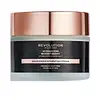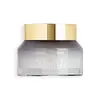What's inside
What's inside
 Key Ingredients
Key Ingredients

 Benefits
Benefits

 Concerns
Concerns

 Ingredients Side-by-side
Ingredients Side-by-side

Water
Skin ConditioningCaprylic/Capric Triglyceride
MaskingShorea Stenoptera Seed Butter
EmollientGlycerin
HumectantPrunus Persica Kernel Oil
EmollientSodium Acrylates Copolymer
Phenoxyethanol
PreservativePolyacrylamide
Lecithin
EmollientC13-14 Isoparaffin
EmollientSodium Hyaluronate
HumectantGlycogen
HumectantChlorphenesin
AntimicrobialLaureth-7
EmulsifyingTocopherol
AntioxidantHelianthus Annuus Seed Oil
EmollientCitric Acid
BufferingWater, Caprylic/Capric Triglyceride, Shorea Stenoptera Seed Butter, Glycerin, Prunus Persica Kernel Oil, Sodium Acrylates Copolymer, Phenoxyethanol, Polyacrylamide, Lecithin, C13-14 Isoparaffin, Sodium Hyaluronate, Glycogen, Chlorphenesin, Laureth-7, Tocopherol, Helianthus Annuus Seed Oil, Citric Acid
Glycerin
HumectantWater
Skin ConditioningRicinus Communis Seed Oil
MaskingCaprylic/Capric Triglyceride
MaskingSqualane
EmollientShorea Stenoptera Seed Butter
EmollientCopernicia Cerifera Cera
EmollientCopernicia Cerifera Wax
Olea Europaea Fruit Oil
MaskingSucrose Stearate
EmollientAmmonium Acryloyldimethyltaurate/Vp Copolymer
Helianthus Annuus Seed Oil
EmollientDicaprylyl Carbonate
EmollientPhenoxyethanol
PreservativeOlea Europaea Callus Culture Lysate
Skin ConditioningSodium Acrylate/Sodium Acryloyldimethyl Taurate Copolymer
Emulsion StabilisingC15-19 Alkane
SolventDisodium EDTA
Ethylhexylglycerin
Skin ConditioningParfum
MaskingTitanium Dioxide
Cosmetic ColorantTocopherol
AntioxidantPolyglyceryl-6 Laurate
EmulsifyingSodium Hyaluronate
HumectantPlumeria Alba Flower Extract
Skin ConditioningAscorbyl Tetraisopalmitate
AntioxidantRetinol
Skin ConditioningPolysorbate 20
EmulsifyingPolyglycerin-6
HumectantCitric Acid
BufferingRosa Centifolia Flower Extract
AstringentCyamopsis Tetragonoloba Gum
Emulsion StabilisingXanthan Gum
EmulsifyingPotassium Sorbate
PreservativeBHT
AntioxidantBHA
AntioxidantSorbic Acid
PreservativeCI 15985
Cosmetic ColorantCI 17200
Cosmetic ColorantCI 19140
Cosmetic ColorantBenzyl Alcohol
PerfumingGeraniol
PerfumingGlycerin, Water, Ricinus Communis Seed Oil, Caprylic/Capric Triglyceride, Squalane, Shorea Stenoptera Seed Butter, Copernicia Cerifera Cera, Copernicia Cerifera Wax, Olea Europaea Fruit Oil, Sucrose Stearate, Ammonium Acryloyldimethyltaurate/Vp Copolymer, Helianthus Annuus Seed Oil, Dicaprylyl Carbonate, Phenoxyethanol, Olea Europaea Callus Culture Lysate, Sodium Acrylate/Sodium Acryloyldimethyl Taurate Copolymer, C15-19 Alkane, Disodium EDTA, Ethylhexylglycerin, Parfum, Titanium Dioxide, Tocopherol, Polyglyceryl-6 Laurate, Sodium Hyaluronate, Plumeria Alba Flower Extract, Ascorbyl Tetraisopalmitate, Retinol, Polysorbate 20, Polyglycerin-6, Citric Acid, Rosa Centifolia Flower Extract, Cyamopsis Tetragonoloba Gum, Xanthan Gum, Potassium Sorbate, BHT, BHA, Sorbic Acid, CI 15985, CI 17200, CI 19140, Benzyl Alcohol, Geraniol
Ingredients Explained
These ingredients are found in both products.
Ingredients higher up in an ingredient list are typically present in a larger amount.
This ingredient is an emollient, solvent, and texture enhancer. It is considered a skin-softener by helping the skin prevent moisture loss.
It helps thicken a product's formula and makes it easier to spread by dissolving clumping compounds.
Caprylic Triglyceride is made by combining glycerin with coconut oil, forming a clear liquid.
While there is an assumption Caprylic Triglyceride can clog pores due to it being derived from coconut oil, there is no research supporting this.
Learn more about Caprylic/Capric TriglycerideCitric Acid is an alpha hydroxy acid (AHA) naturally found in citrus fruits like oranges, lemons, and limes.
Like other AHAs, citric acid can exfoliate skin by breaking down the bonds that hold dead skin cells together. This helps reveal smoother and brighter skin underneath.
However, this exfoliating effect only happens at high concentrations (20%) which can be hard to find in cosmetic products.
Due to this, citric acid is usually included in small amounts as a pH adjuster. This helps keep products slightly more acidic and compatible with skin's natural pH.
In skincare formulas, citric acid can:
While it can provide some skin benefits, research shows lactic acid and glycolic acid are generally more effective and less irritating exfoliants.
Most citric acid used in skincare today is made by fermenting sugars (usually from molasses). This synthetic version is identical to the natural citrus form but easier to stabilize and use in formulations.
Read more about some other popular AHA's here:
Learn more about Citric AcidGlycerin is already naturally found in your skin. It helps moisturize and protect your skin.
A study from 2016 found glycerin to be more effective as a humectant than AHAs and hyaluronic acid.
As a humectant, it helps the skin stay hydrated by pulling moisture to your skin. The low molecular weight of glycerin allows it to pull moisture into the deeper layers of your skin.
Hydrated skin improves your skin barrier; Your skin barrier helps protect against irritants and bacteria.
Glycerin has also been found to have antimicrobial and antiviral properties. Due to these properties, glycerin is often used in wound and burn treatments.
In cosmetics, glycerin is usually derived from plants such as soybean or palm. However, it can also be sourced from animals, such as tallow or animal fat.
This ingredient is organic, colorless, odorless, and non-toxic.
Glycerin is the name for this ingredient in American English. British English uses Glycerol/Glycerine.
Learn more about GlycerinHelianthus Annuus Seed Oil is the oil derived from the seeds of a Sunflower. Sunflower seed oil is non-fragrant. It is an emollient, meaning it helps to soften the skin.
Sunflower seed oil contains many fatty acids. The fatty acids found in sunflower seeds include (from highest amount to least): linoleic acid, myristic acid, palmitic acid, stearic acid, arachidic acid, oleic acid, and linolenic acid.
These fatty acids help the skin create ceramides. Ceramides play a role in repairing the skin barrier.
Helianthus Annuus Seed Oil helps moisturize the skin. This in turn helps the skin look more rejuvenated and smoother.
Sunflowers are rich in vitamin E.
Historians believe Indigenous cultures of North America domesticated sunflowers before corn. Thus they relied on sunflower oil for a variety of uses. One such use is moisturizing skin and hair.
Sunflower seed oil may not be fungal acne safe. We recommend speaking with a professional if you have any concerns.
Learn more about Helianthus Annuus Seed OilPhenoxyethanol is a preservative that has germicide, antimicrobial, and aromatic properties. Studies show that phenoxyethanol can prevent microbial growth. By itself, it has a scent that is similar to that of a rose.
It's often used in formulations along with Caprylyl Glycol to preserve the shelf life of products.
Shorea Stenoptera Seed Butter isn't fungal acne safe.
Sodium Hyaluronate is hyaluronic acid's salt form. It is commonly derived from the sodium salt of hyaluronic acid.
Like hyaluronic acid, it is great at holding water and acts as a humectant. This makes it a great skin hydrating ingredient.
Sodium Hyaluronate is naturally occurring in our bodies and is mostly found in eye fluid and joints.
These are some other common types of Hyaluronic Acid:
Learn more about Sodium HyaluronateTocopherol (also known as Vitamin E) is a common antioxidant used to help protect the skin from free-radicals and strengthen the skin barrier. It's also fat soluble - this means our skin is great at absorbing it.
Vitamin E also helps keep your natural skin lipids healthy. Your lipid skin barrier naturally consists of lipids, ceramides, and fatty acids. Vitamin E offers extra protection for your skin’s lipid barrier, keeping your skin healthy and nourished.
Another benefit is a bit of UV protection. Vitamin E helps reduce the damage caused by UVB rays. (It should not replace your sunscreen). Combining it with Vitamin C can decrease sunburned cells and hyperpigmentation after UV exposure.
You might have noticed Vitamin E + C often paired together. This is because it is great at stabilizing Vitamin C. Using the two together helps increase the effectiveness of both ingredients.
There are often claims that Vitamin E can reduce/prevent scarring, but these claims haven't been confirmed by scientific research.
Learn more about TocopherolWater. It's the most common cosmetic ingredient of all. You'll usually see it at the top of ingredient lists, meaning that it makes up the largest part of the product.
So why is it so popular? Water most often acts as a solvent - this means that it helps dissolve other ingredients into the formulation.
You'll also recognize water as that liquid we all need to stay alive. If you see this, drink a glass of water. Stay hydrated!
Learn more about Water